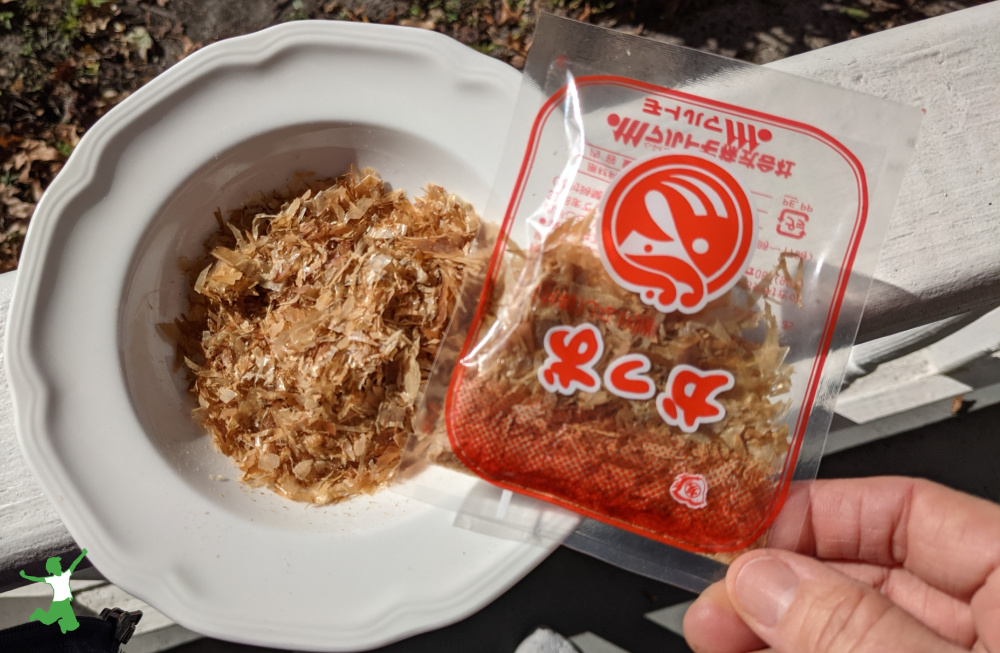How to quickly make a quart of bonito broth using traditional Japanese skipjack flakes from the health food store or Asian supermarket as an inexpensive and healthy base for soups and sauces.
Bonito flakes are a delicious and extremely fast way to whip up a pot of economical fish stock.
It is wonderful to sip alone or as a base for soup as used traditionally in Japanese cuisine. Here’s what ancient South American proverbs have to say on the matter:
“Fish stock will cure anything”
“Good broth will resurrect the dead”
I personally feel that fish stock is a must cooking skill to teach children before they leave home. It is easy to make, and absolutely the fastest of all traditional broth recipes.
I recently taught my teenage son how to make fish stock with fish heads and bonito flakes.
He couldn’t believe how easy it was. Show them once and they will never forget! It’s that easy.
What is Bonito Broth?
Bonito broth, also called dashi, is a fish stock traditional to Japan.
It is traditionally mixed with fermented miso paste to make soup.
This miso brand is unpasteurized and of excellent quality.
The broth is either sipped alone or mixed with meat, noodles, seaweed, or small cubes of tofu.
When I stayed in a Japanese monastery in Kyoto right after college, I noticed that the monks enjoyed a nourishing cup of fish stock served at breakfast with cold poached eggs, fish and vegetables.
Health Benefits
The Japanese have historically valued bonito broth as a remedy for colds and fatigue and to improve blood circulation.
The Journal of Clinical Biochemistry and Nutrition reported in 2008 a randomized human trial of 27 elderly Japanese subjects who ingested broth made from bonito flakes or water for one month.
At the conclusion of the trial, the people who ingested bonito broth during the study had far improved systolic blood pressure readings than those ingesting plain water.
In addition, the bonito broth drinking subjects had a much improved emotional state.
What are Bonito Flakes?
Bonito flakes are made from dried, fermented, and smoked skipjack tuna.
Note that skipjack is one of the safest forms of tuna as they are shorter-lived and much smaller than albacore and bluefin.
Traditionally, Japanese women kept blocks of the dried bonito and used a kitchen tool to flake off as much as they needed each day. Nowadays the flakes are sold in bags.
Unfortunately, homemade dashi made from dried kelp and katsuobushi (bonito flakes) is rare today, even in Japan.
Most people use granulated or liquid instant stock, which is typically full of MSG for flavor instead of the natural and delicious flavor from the bonito flakes.
Beware of bonito broth substitutes!
Budget Friendly and Space Saving
Broth made from bonito flakes is especially helpful for a young adult or family on a limited budget with limited space.
Because you can make a pot in just a few minutes, it can be made as needed rather than making huge batches and freezing large quantities like with chicken or beef stock.
It is the most economical stock too: less than a dollar’s worth of bonito flakes makes a quart of stock in a hurry.
The picture above is of a package of bonito flakes from a local Asian supermarket. They cost less than a dollar each! One packet of bonito flakes will make a quart of bonito broth.
This compares with a pot of chicken stock which takes 24 hours to make with quality pastured chicken that is very expensive and sometimes hard to find.
Quick Fish Stock Not a Sub for Bone Broth
Is bonito broth a substitute for slow cooked chicken or beef stock? No.
The reason is that bonito broth does not contain gelatin like the slow cooked versions made from bones.
However, bonito broth is incredibly nutritious nonetheless and is a great adjunct to slow cooked bone broths to keep the budget in check and for quick meals in a hurry.
Hard to Find Fresh Fish? Use Bonito Flakes Instead
If you need fish broth asap, don’t have any fish heads on hand or don’t have a place to buy fish heads in your town because you aren’t near the coast, you can make bonito fish broth instead.
Best to keep a number of these handy little packets in your pantry to use in a pinch!
How to Make Broth from Bonito Flakes
The easy recipe below makes one quart of bonito broth. It is a great stand-in for bone broth if the freezer is temporarily empty.
Drink bonito broth by itself, mix with miso or use as a base for seafood gumbo, clam chowder or other similar soups.
Another soup recipe using bonito broth is this fast, healthy ramen soup!
You can find the dried flakes at health food stores, Asian groceries, and online here.

Bonito Broth Recipe
Easy recipe for bonito flakes made into broth (quick fish stock) that is delicious and highly economical as a base for soups and sauces when bone broth is unavailable.
Ingredients
- 1 quart filtered water
- 1 packet bonito flakes or 3 grams
- 2 Tbl organic miso paste optional, preferably unpasteurized
Instructions
-
Bring filtered water to a boil.
-
Remove pan from heat and add a half cup of the bonito flakes.
-
Cover and allow the bonito flakes to sink to the bottom of the pot. This will take a few minutes.
-
Strain out the bonito flakes and discard or sprinkle them on your dog or cat’s food.
-
Add miso paste and slowly stir until well blended.
-
The broth has a smoky, hearty flavor similar to that of beef stock.










I just spent about 45 min searching your blog and combing through the soup/broth links after watching one of your broth videos that said to search your blog for your chowder and gumbo recipes and I found no such recipes??? Can someone link me to them if they actually exist and I am not searching properly? The only links I find are to posts that talk about using a broth in those soups but no actual recipes for those soups. Thanks.
A little late, but this looks like the chowder one:
https://www.thehealthyhomeeconomist.com/optimal-foods-for-physical-fitness-plus-3-recipes/#more-8328
Can’t find a gumbo recipe.
Ohh man!!! Thanks so much for this Sarah! I am in my last year of university at Western here in London and I keep telling my friends to drink bone broth when they are sick haha! Broth is also excellent for my digestion and my skin 🙂 I am going to play around with this and make some soups with it! We have this little Asian market here too that I love going to and I’m going to get me some Bonito! Damn that’s catch. Bonito!!! Thanks again 🙂
RE: safety of bonita flakes from radiation….My package says “product of Japan” …so, wouldn’t the bonita be in Japanese waters? I read where the skipjack is from tropical waters but if the package says again, product of Japan..that must be the country of origin and therefore possibly contaminated with radiation?
It’s nothing to be overly concerned about. Japan has set food standards and wouldn’t allow something potentially fatal be marketed. Also, the fish could have been farm raised and not have a chance of swimming in radiation.
What about mercury content?
Being from Japan, I have some reliable resources of how much radiation they are dumping into the ocean since the incident. I used to use bonito flakes a lot before but never now and will never use it personally in the future.
The package is up side down by the way.
Thanks! Need to reshoot that picture 🙂
Also, I would not be overly concerned about bonito flakes … skipjack tuna come from tropical waters, not Northern Pacific waters near Japan.
Hi Yoko. Any idea if Kombu from Japan is safe after the incident? I love using it when I make chicken and beef broth, and beans.
I am not a scientist. I am an educated person though, and I love everything Japanese including the people. However, I refuse to purchase any Japanese food products, imported ceramics like tea pots, green tea or even clothing/books/etc. post Fukushima. I do not eat fish period, no matter whether ocean, stream or river fish. I don’t ask anyone else to follow my code of behavior, but I am true to the determination I made.
Your link for bonito flakes says they are from japan — I don’t see any bonito flakes on your resource list…. can you specifically name the brand you buy? I have never purchased before & would prefer not to get them from Japan. Thank you!
I would love to try bonito flakes! My only concern is added MSG, which I have found on every (English) label of bonito flakes I have ever come across. The one referenced on Amazon is apparently written in Japanese, so the seller says he/she doesn’t know whether MSG has been added. If you know of any bonito flakes that have no added MSG, please let us know. Thanks! 🙂
Oh, Sarah, THANK YOU! It is especially comforting that this broth doesn’t taste fishy. I wouldn’t mind if it did, but my partner can’t even tolerate the smell when I eat salmon or tuna near him. The only time I’ve seen him actually enjoy seafood was when he had some extremely mild lenguado fish cooked in butter. If I could use this bonito broth to get him to eat fish, I’d rest so much easier.
I’m also not sure I could tolerate handling fish heads, at least not yet…. And we’re not very wealthy, so an alternative like bonito is appealing. I had no idea it was such nutritious stuff.
Thank you very much for sharing the recipe and ingredient sources.
My daughter can’t stand fish smells either but tolerates this just fine when I make it. Hopefully your partner will agree 🙂
Would adding collagen hydrolysate help to make it more like chkn/beef stock?
Would adding Great Lakes Collagen Hydrolysate make it comparable to chicken/beef stock?
I don’t think it would be exactly the same as unprocessed gelatin from a slow cooked broth, but it would be close and certainly beneficial to the digestive system.